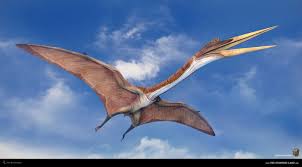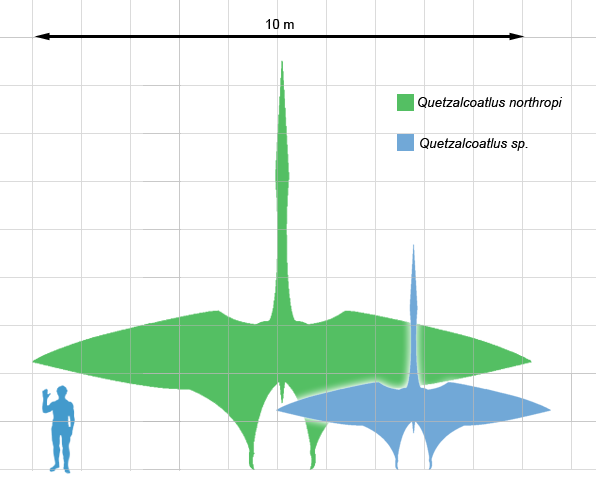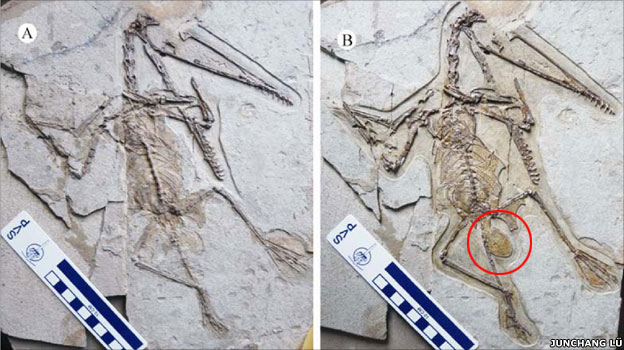Quetzalcoatlus was the largest pterosaur that ever lived; in fact, this airplane-sized reptile was the largest animal ever to take to the skies, period. Here are 10 facts you may (or may not) have known about Quetzalcoatlus.
1. Quetzalcoatlus was named after an Aztec god.
Flying, feathered, reptilian deities have figured in Central American mythology since at least 500 A.D. The Aztec god Quetzalcoatl literally translates as “feathered serpent;” even though Quetzalcoatlus didn’t have feathers, the reference seemed appropriate when this giant pterosaur was first described back in 1971. (And no, this doesn’t mean that pterosaurs flew the skies during Aztec times!)
2. The wingspan of Quetzalcoatlus exceeded 30 feet.
Although its exact proportions are still a matter of dispute, there’s no doubt that Quetzalcoatlus had an enormous wingspan, exceeding 30 feet from tip to tip and possibly attaining breadths of up to 40 feet–about the size of a small private jet. By way of comparison, the largest flying bird alive today, the Andean Condor, has a wingspan of only 10 feet and weighs an order of magnitude less.
3. Quetzalcoatlus probably had a cold-blooded metabolism.
As was the case with all pterosaurs, the wings of Quetzalcoatlus consisted of bare, extended flaps of leathery skin. The lack of accompanying feathers implies that Quetzalcoatlus possessed a reptilian, cold-blooded metabolism, in sharp contrast to the feathered theropod dinosaurs it coexisted with during the late Cretaceous period (which may well have possessed endothermic metabolisms).
4. Quetzalcoatlus took off using both its front and hind legs…
The enormous size of Quetzalcoatlus poses some serious issues, not least of which is how it launched itself into flight. One analysis suggests that this pterosaur vaulted itself into the air with its heavily muscled front legs, and only secondarily used its long, spindly hind limbs. There’s also a case to be made that Quetzalcoatlus preferred to launch itself over the edge of steep cliffs!
5. …and flew without flapping its wings.
Assuming that it had a cold-blooded metabolism, Quetzalcoatlus would have been unable to continuously flap its wings while in flight (a task that requires enormous amounts of energy). According to one analysis, this pterosaur preferred to glide through the air at elevations of 10,000 to 15,000 feet and speeds as fast as 80 miles per hour, only occasionally pivoting its gigantic wings.
6. …that is, if it even flew at all.
Just because Quetzalcoatlus was a pterosaur doesn’t necessarily mean that it was capable of (or interested in) flight. Some paleontologists insist that Quetzalcoatlus was actualy adapted for life on land, and hunted its prey on two feet like a big, gangly theropod. Still, it’s unclear, evolutionarily speaking, why Quetzalcoatlus would have retained such huge wings if it spent all its time on the ground.
7. Quetzalcoatlus was an “azhdarchid” pterosaur.
Although it was certainly one of the biggest, Quetzalcoatlus wasn’t the only plus-sized pterosaur of the late Cretaceous period. Other “azhdarchid” pterosaurs, as they’re called by paleontologists, include Alanqa, Hatzegopteryx, and the poorly understood Azhdarcho; these azhdarchids were also closely related to the South American Tupuxuara and Tapejara.
8. It’s uncertain how much Quetzalcoatlus weighed…
Perhaps because paleontologists can’t quite wrap their minds around a flying reptile the size of fighter jet, there has been considerable disagreement about how much Quetzalcoatlus weighed. Early estimates posited a relatively svelte (and aerodynamic) 200 to 300 pounds, but recent studies suggest that this pterosaur may have weighed as much as a quarter of a ton.
9. …or what it ate for lunch and dinner.
When Quetzalcoatlus was first discovered, its long, narrow beak suggested that this pterosaur skimmed over the shallow seas of late Cretaceous North America, spearing fish and marine reptiles; one paleontologist has even speculated that it scavenged the corpses of deceased titanosaurs. It now seems more likely that Quetzalcoatlus hunted terrestrial animals, including small dinosaurs.
10. Quetzalcoatlus went extinct 65 million years ago.
As any Triceratops or Tyrannosaurus Rex will tell you, sheer size is no insurance policy against oblivion. Along with its fellow pterosaurs, Quetzalcoatlus went extinct at the end of the Cretaceous period, succumbing to the same environmental pressures (including a severe disruption of the food chain) as its dinosaur and marine reptile cousins in the wake of the K/T meteor impact.



 August 22nd, 2014
August 22nd, 2014  Riffin
Riffin 


 Posted in
Posted in  Tags:
Tags: 